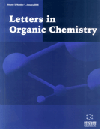- Home
- A-Z Publications
- Letters in Organic Chemistry
- Previous Issues
- Volume 20, Issue 3, 2023
Letters in Organic Chemistry - Volume 20, Issue 3, 2023
Volume 20, Issue 3, 2023
-
-
Decomposition Kinetics of 1,1-Dihydroperoxycyclohexane in Some Organic Solvents
More LessBackground: 1,1-Bishydroperoxides are used as oxidizing agents, radical initiators, in addition, studies of biological activity show the promise of this area of research. Objective: There are currently no kinetic data on the thermal stability of these peroxides in various solvents. Therefore, we investigated the thermal stability of 1,1-dihydroperoxycyclohexane as the most widely used at present. Methods: The rate constants and Read More
-
-
-
Vilsmeier-Haack Cyclisation as a Facile Synthetic Route to Thieno [2,3- b] Quinolines (Part I)
More LessAuthors: Ameen A. Abu-Hashem, Ahmed A.M. Abdelgawad and Moustafa A. GoudaQuinoline ring system is extensively dispensed in natural products, especially in alkaloids. Moreover, thieno[2,3-b]quinolines have vast biological activities, including urea transporter inhibition, anti-microbial, antitumor, antioxidant, anti-inflammatory, and antiproliferative EGFR tyrosine kinase inhibition. Vilsmeier-Haack is considered the most facile and promising set of synthetic routes, leading to 2-chloro-3-formylquinolines thr Read More
-
-
-
The Synthesis of Amides from Benzoic Acids and Dicarbodiimides Under Catalyst-Free Conditions
More LessAuthors: Fengtian Wu, Fangming Yan, Rong Zeng, Yijia Sun, Xiuping Liu, Caihong Zhang, Yenan Chen, Ling Wu and Chunna CuiAmides are a critical class of widely distributed heterocycles in nature. The preparation of amides from benzoic acids and dicarbodiimides under catalyst-free conditions was reported. Various products were obtained in good to high yields. The model reaction could be scaled up to the gramscale level. A reaction mechanism was proposed based on control experiments and relevant literatures.
-
-
-
Weak Interactions between Epinephrine and Thymine
More LessBy Ling PeiThe weak interactions between epinephrine and thymine were investigated by combining the 6-311+G(d,p) basis set with the M06-2X method based on density functional theory. Results suggest that epinephrine and thymine form 22 steady geometries through weak interactions, which primarily contain hydrogen bonds and π–π stacking. Hydrogen bonding is the main character. In addition, the interaction energies range Read More
-
-
-
Nitrogen-doped Graphene Oxide: Production and its Applications in Onepot Five-component Reaction of Highly Substituted Tetrahydropyridines
More LessAuthors: Shahnaz Rostamizadeh, Bahram Zamiri and Mehrdad MahkamThis article proposes a new and facile method to prepare a carbon-based catalyst entitled graphene oxide quantum dots that contain nitrogen-doped groups (GOQDs-N-doped), and which are bioactive and safe possessing economical free transition metal properties. In this study, GOQDs-Ndoped was synthesized by means of the pyrolysis of citric acid at 180°C in the presence of ammonia. The prepared catalyst, which em Read More
-
-
-
An Immune-suppressive Triterpenoid from the Stem of Kadsura coccinea
More LessAuthors: Jiaxin Tian, Kunyu Li, Guanghai Ma, Yong Cui and Feng GaoKadsura coccinea has been used as a folk medicine in China, treating various diseases, including chronic gastritis and rheumatoid arthritis (RA). Chemical studies have revealed that lignans and triterpenes are the main constituents of its roots and stems. In this paper, a chemical investigation on the stem of K. coccinea was performed and a previously undescribed 3,4-secolanostane (1) was afforded. The structure of 1 was det Read More
-
-
-
Intestinal Epithelial Protective Chalone Glycoside from the Roots of Glycyrrhiza uralensis
More LessAuthors: Xiaolu Chen, Yajun Wang, Meixia Tan, Jiang Liu, Nanfeng Luo, Xinru Liang, Yong Cui and Gang ChenGlycyrrhiza uralensis has been used as a traditional medicine for generations. Chalcones are one of the typical chemical constituents of G. uralensis. In this paper, phytochemical research on roots of G. uralensis was performed, leading to the isolation and identification of a previously undescribed chalcone glycoside (1). Its structure was established by means of comprehensive spectral analysis and acid hydrolysis. Mor Read More
-
-
-
Synthesis and Characterization of New Bistriazole Quinazolinediones and their Urease Inhibition Activities
More LessAuthors: Gülay Akyüz and Emre MenteşeA new series of bisthiosemicarbazide and bistriazole molecules bridged quinazolinedione was synthesized and characterized by FT-IR, 1H and 13C-NMR spectral data. Antiurease activities of all new compounds were tested according to the phenol-hypochlorite method by Weatherburn. All compounds have effective urease inhibition activities compared to the standard inhibitor thiourea and previously synthesized quinazolin Read More
-
-
-
One Pot Synthesis of Benzothiazole Derivatives by Nano Silica-based Complex in an Aqueous Medium
More LessWe successfully synthesized novel silica-supported Ni (II)-PLP-ONNO Schiff base/SBA- 15 complex, as a mesoporous catalyst, whose characterization was determined using X-ray diffraction analysis, Fourier-transform infrared spectroscopy, scanning electron microscopy, transmission electron microscopy, inductively coupled plasma-atomic emission spectroscopy, nitrogen adsorption desorption isotherms (BET-EDX) and (BET-BJ Read More
-
-
-
Simplified Procedure for Application of DBE, the Rule of 13 & Nitrogen Rule in Structure Elucidation of Organic Compounds
More LessAuthors: Rachna Kathal, Shivangi Sharma, Kuldeep Singh and Shivendra SinghDetermination of the exact structure of any compound is an extremely critical task. Primarily organic chemistry relies on NMR, IR & Mass spectrometric data. Authors have experienced that introduction of structure elucidation in undergraduate courses and postgraduate courses are helpful for students later in their research careers. Based on our experience, this article discusses double bond equivalents, the rule of 1 Read More
-
Volumes & issues
-
Volume 22 (2025)
-
Volume 21 (2024)
-
Volume 20 (2023)
-
Volume 19 (2022)
-
Volume 18 (2021)
-
Volume 17 (2020)
-
Volume 16 (2019)
-
Volume 15 (2018)
-
Volume 14 (2017)
-
Volume 13 (2016)
-
Volume 12 (2015)
-
Volume 11 (2014)
-
Volume 10 (2013)
-
Volume 9 (2012)
-
Volume 8 (2011)
-
Volume 7 (2010)
-
Volume 6 (2009)
-
Volume 5 (2008)
-
Volume 4 (2007)
-
Volume 3 (2006)
-
Volume 2 (2005)
-
Volume 1 (2004)
Most Read This Month
Article
content/journals/loc
Journal
10
5
false
en


